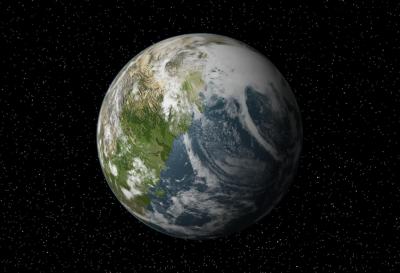BY LETTER
Gaian Type
Earth-like Terrestrial Worlds | |
 Image from Steve Bowers | |
| Nova Terra, a Gaian class planet which currently has a single supercontinent; this type of world is sometimes known as the 'pangaean' subtype | |
Any Earth-like terrestrial world, of which there are many diverse forms depending on water content, composition and temperature.
These are the worlds that many Terragens seek the most, and yet they can come in a wide variety of forms, even when apparently identical to Earth. In the most general of terms, however, Gaian planets are worlds that have a self-perpetuating tectonic cycle maintained by the planet's inner heat and the lubricating effect of the oceans. The presence of life aids in maintaining the oceans and the atmosphere, just as the oceans and atmosphere allow for the presence of life. Gaian worlds are among the most complex of planetary systemics. The tectonic plates of a Gaian world form early on in the planet's history, but can significantly change over periods of hundreds of millions of years. Some Gaian worlds have numerous and small plates, while others have only a few very large plates. These factors often determine the size of the continents and oceans. The atmosphere of a Gaian world is formed by volcanic out-gassing and cometary inputs, but also maintained and often transformed by the presence of life. While certain elements may vary, for the most part oxygen and nitrogen are the most common and most essential parts of these atmospheres. Life itself can become quite prolific and varied, even producing sapient species. But it is also fragile, and though microbial life is often difficult to eradicate, it does not take much of a global temperature or environmental change to wipe out much of the higher forms.
This type of world consists of a solid mostly iron inner core, a molten liquid outer core, a mostly solid mantle made up largely of peridotite or similar material, and a solid granitic, basaltic, and sedimentary crust, consisting largely of oxygen, silicon and aluminium. Generally some ninety to ninety-six percent of a typical Gaian geosphere is composed of the elements oxygen, iron, silica, and magnesium. These planets share a common method of geologic, biologic, and atmospheric evolution. There is almost always an ocean of liquid water. Practically all Gaian type planets support carbon-based life of some sort, usually prokaryotic or equivalent, more rarely metazoan and metaphyta type biota.
Major categories include:
- EoGaian Subtype: Young terrestrial worlds; these may develop into Gaian, Cytherean or Arean worlds later More information here
- MesoGaian Subtype: Earth-like worlds with primitive biospheres More information here
- Eugaian Subtype A mature Gaian world with life, also known as a Garden World More Information Here
- GaianTundral Subtype: Cold Gaian worlds with periodic, or persistent, ice ages More Information Here
- Campian Subtype: Dry Gaian worlds with 25% to 50% ocean cover More Information Here
- Paludial Subtype: Humid Gaian worlds with 25% to 50% ocean cover More Information Here
- Lacustric Subtype:Humid Gaian worlds with low topography and 50-80% ocean coverage; some of these worlds have extensive rainforest-type biomes More Information Here
- Chlorogaian (Halogenic) type: Gaian worlds with high levels of atmospheric chlorine. More: Chlorine Worlds
- To'ul'hese Worlds: These worlds are essentially Gaian versions of the Cytherean worlds. Thick and dense atmospheres, as well as a large amount of water, create high surface pressures and high temperatures. Life arises and adapts to these conditions, and can become quite diverse indeed. In one known instance, it has lead to an independent form of sapient life. More; To'ul'hian Worlds
- Pelagic Subtype Gaian worlds where oceans cover the surface anywhere from 85 to 100%. More Information here
- EuPelagic Subtype Gaian worlds where shallow oceans cover the surface anywhere from 85 to 100%. More information here
- BathyPelagic Subtype: Gaian worlds where deep oceans cover the surface anywhere from 85 to 100%. More information here
- PelaGelidic Subtype, ice covered ocean worlds More information here
- TundralPelagic subtype, partially ice covered ocean worlds More information here
- Xeric subtype Dry worlds with less than 25% ocean cover More information here
- HyperXeric subtype Very dry worlds with less than 10% ocean cover More information here
- PostGaian subtype: Old Gaian Worlds that are losing their biosphere and hydrosphere. More information here.
Related Articles
Appears in Topics
Development Notes
Text by John M. Dollan
Initially published on 01 November 2001.
Initially published on 01 November 2001.






